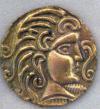Asteroid Hygiea, in Inner Solar System, Is Smallest Dwarf Planet Say Astronomers

A new SPHERE/VLT image of Hygiea, which could be the Solar System’s smallest dwarf planet yet. As an object in the main asteroid belt, Hygiea satisfies right away three of the four requirements to be classified as a dwarf planet: it orbits around the Sun, it is not a moon and, unlike a planet, it has not cleared the neighborhood around its orbit. The final requirement is that it have enough mass that its own gravity pulls it into a roughly spherical shape. This is what VLT observations have now revealed about Hygiea.
Credit: ESO/P. Vernazza et al./MISTRAL algorithm (ONERA/CNRS)
Astronomers using the SPHERE instrument on ESO’s Very Large Telescope have revealed that the asteroid Hygiea could be a dwarf planet. Find out more about this fascinating object in the new ESOcast Light.
Credit: ESO
New observations with ESO’s SPHERE instrument on the Very Large Telescope have revealed that the surface of Hygiea lacks the very large impact crater that scientists expected to see on its surface. Since it was formed from one of the largest impacts in the history of the asteroid belt, they were expecting to find at least one large, deep impact basin, similar to the one on Vesta (bottom right in the central panel).
The new study also found that Hygiea is spherical, potentially taking the crown from Ceres as the smallest dwarf planet in the Solar System. The team used the SPHERE observations to constrain Hygiea’s size, putting its diameter at just over 430 km, while Ceres is close to 950 km in size.
Credit: ESO/P. Vernazza et al., L. Jorda et al./MISTRAL algorithm (ONERA/CNRS)
This animation shows where Hygiea’s orbit is in our Solar System. Like Ceres, Hygiea is in the main asteroid belt, which is located between the orbits of Mars and Jupiter. While Hygiea was thought to be an asteroid, new observations with the SPHERE instrument on the VLT have revealed that Hygiea is spherical in shape, meaning it could be reclassified as a dwarf planet. This would make it the smallest dwarf planet yet in our Solar System, after Ceres.
Credit: ESO/spaceengine.org
The team also used the SPHERE observations to constrain Hygiea’s size, putting its diameter at just over 430 km. Pluto, the most famous of dwarf planets, has a diameter close to 2400 km, while Ceres is close to 950 km in size.
Surprisingly, the observations also revealed that Hygiea lacks the very large impact crater that scientists expected to see on its surface, the team report in the study published today in Nature Astronomy. Hygiea is the main member of one of the largest asteroid families, with close to 7000 members that all originated from the same parent body. Astronomers expected the event that led to the formation of this numerous family to have left a large, deep mark on Hygiea.
“This result came as a real surprise as we were expecting the presence of a large impact basin, as is the case on Vesta,” says Vernazza. Although the astronomers observed Hygiea’s surface with a 95% coverage, they could only identify two unambiguous craters. “Neither of these two craters could have been caused by the impact that originated the Hygiea family of asteroids whose volume is comparable to that of a 100 km-sized object. They are too small,” explains study co-author Miroslav Brož of the Astronomical Institute of Charles University in Prague, Czech Republic.
The team decided to investigate further. Using numerical simulations, they deduced that Hygiea’s spherical shape and large family of asteroids are likely the result of a major head-on collision with a large projectile of diameter between 75 and 150 km. Their simulations show this violent impact, thought to have occurred about 2 billion years ago, completely shattered the parent body. Once the left-over pieces reassembled, they gave Hygiea its round shape and thousands of companion asteroids. “Such a collision between two large bodies in the asteroid belt is unique in the last 3–4 billion years,” says Pavel Ševeček, a PhD student at the Astronomical Institute of Charles University who also participated in the study.
Computational simulation of the fragmentation and reassembly that led to the formation of Hygiea and its family of asteroids, following an impact with a large object. While changes in the shape of Hygiea occur after the impact, the dwarf-planet candidate eventually acquires a round shape.
Credit: P. Ševeček/Charles University
Studying asteroids in detail has been possible thanks not only to advances in numerical computation, but also to more powerful telescopes. “Thanks to the VLT and the new generation adaptive-optics instrument SPHERE, we are now imaging main belt asteroids with unprecedented resolution, closing the gap between Earth-based and interplanetary mission observations,” Vernazza concludes.
Contacts and sources:
Bárbara Ferreira
ESO (European Southern Observatory)
Pierre Vernazza
Laboratoire d’Astrophysique de Marseille
Charles University
Pavel Ševeček
Charles University
Links:
Research paper
Supplementary material
New SPHERE view of VESTA
VLT’s SPHERE spies rocky worlds
SPHERE maps the surface of Ceres
Photos of the VLT
P. Vernazza, L. Jorda, P. Ševeček, M. Brož, M. Viikinkoski, J. Hanuš, B. Carry, A. Drouard, M. Ferrais, M. Marsset, F. Marchis, M. Birlan, E. Podlewska-Gaca, E. Jehin, P. Bartczak, G. Dudzinski, J. Berthier, J. Castillo-Rogez, F. Cipriani, F. Colas, F. DeMeo, C. Dumas, J. Durech, R. Fetick, T. Fusco, J. Grice, M. Kaasalainen, A. Kryszczynska, P. Lamy, H. Le Coroller, A. Marciniak, T. Michalowski, P. Michel, N. Rambaux, T. Santana-Ros, P. Tanga, F. Vachier, A. Vigan, O. Witasse, B. Yang, M. Gillon, Z. Benkhaldoun, R. Szakats, R. Hirsch, R. Duffard, A. Chapman, J. L. Maestre. Nature Astronomy, 2019; DOI: 10.1038/s41550-019-0915-8
Source:
Anyone can join.
Anyone can contribute.
Anyone can become informed about their world.
"United We Stand" Click Here To Create Your Personal Citizen Journalist Account Today, Be Sure To Invite Your Friends.
Please Help Support BeforeitsNews by trying our Natural Health Products below!
Order by Phone at 888-809-8385 or online at https://mitocopper.com M - F 9am to 5pm EST
Order by Phone at 866-388-7003 or online at https://www.herbanomic.com M - F 9am to 5pm EST
Order by Phone at 866-388-7003 or online at https://www.herbanomics.com M - F 9am to 5pm EST
Humic & Fulvic Trace Minerals Complex - Nature's most important supplement! Vivid Dreams again!
HNEX HydroNano EXtracellular Water - Improve immune system health and reduce inflammation.
Ultimate Clinical Potency Curcumin - Natural pain relief, reduce inflammation and so much more.
MitoCopper - Bioavailable Copper destroys pathogens and gives you more energy. (See Blood Video)
Oxy Powder - Natural Colon Cleanser! Cleans out toxic buildup with oxygen!
Nascent Iodine - Promotes detoxification, mental focus and thyroid health.
Smart Meter Cover - Reduces Smart Meter radiation by 96%! (See Video).





